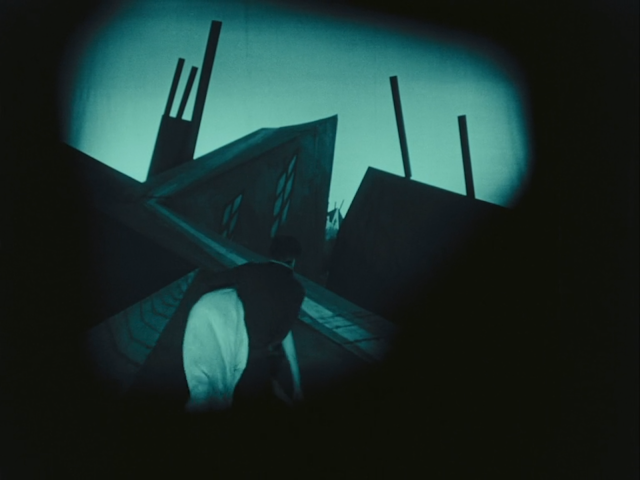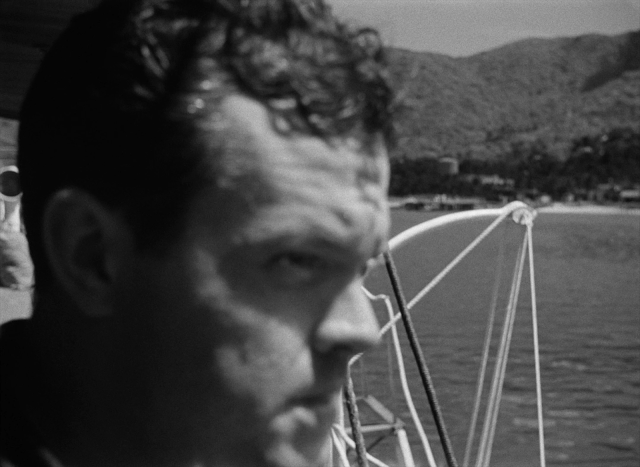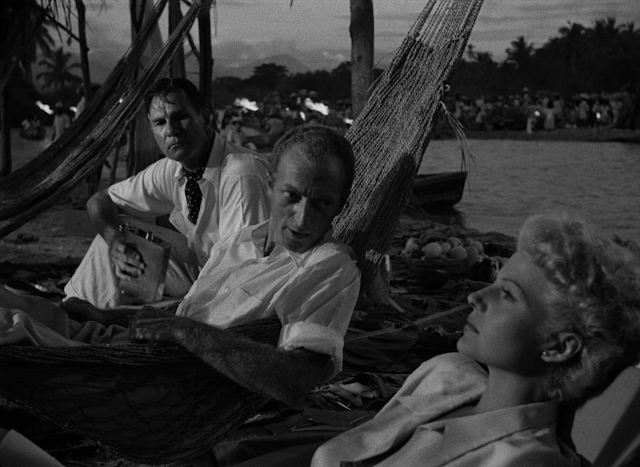Week Thirty-One: The Lady from Shanghai (1948)
Producer: Orson Welles
Writer: Orson Welles
Cinematography: Charles Lawton Jr.
Music: Heinz Roemheld
Studio: Columbia
Starring: Rita Hayworth (Elsa “Rosalie” Bannister), Orson Welles (Michael O’Hara), Everett Sloane (Arthur Bannister), Glenn Anders (George Grisby), Ted de Corsia (Sideny Broome), Gus Schilling (Goldie), Evelyn Ellis (Bessie), Louis Merrill (Jake), Erskine Sanford (Judge), Carl Frank (Galloway)
In Hollywood during the thirties and forties, the studio was king. No matter how much we (quite rightly) celebrate the work of talented directors and occasionally the hands-on producer, the truth is that the true power lay with the studio executives. These men – including Louis B. Mayer and Irving Thalberg (MGM), Harry Cohn (Colombia), Darryl F. Zanuck (20th Century-Fox), Adolph Zukor (Paramount), and Jack Warner (Warner Bros.) – occasionally dabbled in producing but for the most part were in charge of the general direction of the studio, though they had and often exercised the right to change pretty much anything they wanted about a movie. Despite the fact that these men were often businessmen, not artists, they often meddled with films, cutting them or forcing changed endings. Several directors – usually those of the most forward thinking and singular artistic vision – elicited more studio interference than others.
No executive was more hands-on than Harry Cohn at Columbia, especially when it came to his studio’s prized star Rita Hayworth. No director had more trouble with studios than Orson Welles. Welles was married to Hayworth and he made a film with her, under Cohn at Columbia. It doesn’t take much deduction to figure that there was a battle over the production of The Lady from Shanghai.
 |
| Rita Hayworth was Columbia's biggest star when she made The Lady from Shanghai |
Welles, probably the most talented and creative director in movie history, had a history of studio clashes. When Welles signed a three-picture deal at RKO, he was given unprecedented control over his films, including an unheard-of right of final cut. For his debut film, Citizen Kane, he had complete control and the results speak for themselves. Welles was compelled to give up his right of final cut and after that point, Welles’ filmography is littered with studio-mandated alterations. Most famously, his next film The Magnificent Ambersons (1942) had sixty minutes removed from Welles’ original cut. Welles wasn’t blameless, but for the most part, the chopping up of movies like Ambersons were business decisions, not artistic ones. Of course, it is the studio’s job to make money but even then, these were short-sighted decisions that didn’t necessarily improve the film’s box office take. There were three Welles films to be considerably altered by the studio: Ambersons, Touch of Evil, and The Lady from Shanghai. That may not seem like much, but it is actually fifty percent of Welles’ six total Hollywood films. The Lady from Shanghai was cut significantly – including much of Welles’ planned finale – but it was altered in other ways from Welles’ initial vision.
In hindsight, The Lady from Shanghai would likely have had problems no matter which studio or star was involved. Welles was the most brilliant stylist of his time, but he was often so far ahead of the pack that producers and executives didn’t understand what he was going for. For The Lady from Shanghai, Welles was attempting to film the vast majority of the film on location.
 |
| A large portion of The Lady from Shanghai was shot on location |
This would become the norm in twenty years but in the forties studios were king and that meant shooting at the studio under controlled conditions – most importantly conditions controlled by the studio executives. Welles partially got his way but so did Cohn: The Lady from Shanghai is comprised of a mix of location and studio shots. And it must be said that perhaps the combination of styles works in the film’s favor because Welles also wanted to film in a semi-documentary style with few close-ups.
 |
| Within the same scene, The Lady from Shanghai jumps from studio shooting... |
 |
| ...to location. |
 |
| Studio... |
 |
| ...location. |
 |
| Even with so much on-location shooting, studio matte paintings were still used on one occasion. |
Forced to do some work in the studio, Welles had to step back from this extremely unusual approach and give us some of the film’s most vital moments: strategic extreme close-ups and uncomfortably angled shots. So we have some good and some bad in the director/studio head dynamic: cutting down portions of the actual film, maybe not so good, but reigning in some of Welles’ more extreme ideas, may be beneficial.
 |
| Unusually for its time, The Lady from Shanghai makes frequent use of Passion of Joan of Arc-esque extreme close-ups |
 |
| From the cramped quarters of a yacht to awkward conversations, the camera simulates claustrophobic closeness. |
Despite the necessary studio work, the stunningly beautiful location shots steal the show. Not just the landscapes either, but also the dark city streets of Acapulco that Rita Hayworth runs through in her white dress. The Lady from Shanghai in general features tremendous and unique settings that make it stand out from the standard, studio-bound look of most forties films.
 |
| A significant portion of the action takes place on the Bannister's boat, which was in real life Errol Flynn's yacht |
 |
| Beautiful cinematography, freed from the studio. |
As a director, Welles obsessed over how his films looked and constantly looked for ways to make the camera see what the eye could see. The camera and actors in simpatico and most significantly to The Lady from Shanghai, some unorthodox cinematic techniques are used, such as the use of natural light and a claustrophobic closeness of compositions.
 |
| The camera as the voyeuristic eye, a cinematic theme Welles shared with Alfred Hitchcock and Michael Powell |
Overall, the look of the film can be categorized as Expressionistic and noir-influenced though because Welles’ work with Gregg Toland on Citizen Kane was so influential on the way forties films looked, it is hard to know exactly where influence and influencer begin and end. Regardless, The Lady from Shanghai has many of the visual touchstones of the genre, including high-contrast and low-key photography, unconventional camera angles, and oblique mise-en-scene. Even in a decade where style went wild, Welles stands out from the rest of Hollywood in his technical mastery and visual flair.
 |
| No director was as creative with his compositions |
 |
| Bannisters in front of a banister: the shadows created by a banister... ...was first used by Welles in The Magnificent Ambersons |
 |
| High contrast photography. |
 |
| Low-key lighting |
 |
| Characters in profile: a recurring visual motif in the Lady from Shanghai |
After You Watch the Movie (Spoilers Below)
The Lady from Shanghai also stands out in its general weirdness. Film noir often delves into the bizarre but this film sets new standards for overall strangeness. Elsa and Michael have their illicit lovers meeting in an aquarium full of school children while various sea animals float around in the background. What the reason for this is, no one knows but it sure looks cool. The same can be said for the Chinese theater where Michael hides after escaping from the trial. Even today, movies often feel over-calculated, carefully crafted to make as much sense as possible while the potential for total tone, story, and visual non-sequiturs is ignored. Whether intentional or not, theses completely random moments in The Lady from Shanghai give the film a unique feel that makes it unlike any other.
 |
| Rita Hayworth and the world's biggest Moray Eel |
 |
| The Chinese theater and the farcical trial are two of the stranger settings in the film |
This also extends to the characters, the two lawyers in particular. Bannister’s crippled stumbling around really doesn’t have much to do with the actual story but they make him stand out as a character, ditto for Grisby’s general eccentricities that borders on insanity. Very little explanation is given for any of the character’s backstory or relationships, we learn a little about Michael’s past and Elsa’s Shanghai Lily-esque life in China but overall there is mostly mystery when it comes to the Bannister/Grisby, Bannister/Elsa, Grisby/Elsa relationships.
 |
| Was Bannister's character given an injury that causes him to walk with two canes... |
 |
| ...just so he could enter the mirror room like this? |
 |
| Grisby stares at Michael while drinking his beer. |
The writing is also strange but brilliant in its own way, whether it be Elsa’s ruminations on Chinese philosophy or Michael’s monologue about a shark feeding frenzy. Grisby again provides next-level weirdness in this area, telling Michael he wants to escape his wife (who doesn’t exist), fake his death to collect insurance (that he can’t collect because he would be “dead”), all before the bombs fall. None of this is really explained but that final reason is actually notable because it is one of the first references to the atomic age and the paranoia of potential nuclear annihilation that will become a major theme in culture in just a few years.
The climax of all this noir-weirdness begins with Michael stumbling through a hellish funhouse. The overall tone of oneirism in The Lady from Shanghai climaxes in the sequence in which the lines between the real and surreal are blurred and Michael stumbles through a Caligari-esque Expressionistic nightmare.
 |
| Michael's funhouse nightmare... |
 |
| ...is pure Caligari-esque expressionism. |
 |
| From Caligari to Metropolis. |
After this, Michael is confronted with countless visions of the woman who used him and Elsa must face an endless parade of husbands she planned to murder. In Citizen Kane, Welles uses the mirrors to represent the fragmented nature of Charles Foster Kane's personality in all his complex glory, but in The Lady from Shanghai instead, we see a fracturing of souls as well as the endlessness reflections of regret.
 |
| From Citizen Kane's infinite Kanes... |
 |
| ...The Lady from Shanghai's mirror room climax. |
Elsa is a classic example of the noir femme fatale: she is seductive and duplicitous, using Michael’s desire for her from the very beginning to execute her plan to eliminate her husband, collect the insurance, and run off with Grisby. She also fools her husband almost to the very end, but not quite. Despite the confusing plot machinations and strangeness, the titular Lady from Shanghai is the driving force of the film, from its first line “When I start out to make a fool of myself, there's very little can stop me. If I'd known where it would end, I'd never let anything start... if I'd been in my right mind, that is. But once I'd seen her, I was not in my right mind for some time,” to it’s last “Maybe I'll live so long that I'll forget her. Maybe I'll die trying.” This is a heavy burden to place on an actor, but Hayworth is up to the task. Early in her stardom, Rita Hayworth was limited to musicals and comedies but by the mid-forties, she began starring in a number of noirs that turned out to be the best performances and films of her career. Hayworth was a talented actress and when given the opportunity could command her considerable pin-up girl sensuality in serious, femme fatale-type roles.
She is aided by Welles camera, which makes the most of her beauty and lingers longingly. Like Marlene Dietrich in Shanghai Express, we know that Elsa is an idea of beauty, desirable and erotic because the camera tells us so. Many beautiful women – which Hayworth certainly was – can be made to look plain by the camera just as they can be turned into a goddess by the same camera. Elsa in The Lady from Shanghai is a screen goddess, if you look for a moment that she doesn’t look beautiful in this film, you won’t find one but there is also a remarkable coldness in Hayworth's performance as well.
 |
| The Lady from Shanghai features an important cameo: Errol Flynn's dachshund! |
Despite this, much has been made of Welles having her bleach her famous red hair, but for this role, she couldn’t be Hayworth the star but needed to be Hayworth the actor. Elsa, though beautiful and brilliant as a character, is also a nasty, conniving piece of work and can be seen as a little bit of a kiss-off from Welles to his soon to be ex-wife.
The Lady from Shanghai is at once strange, confusing, weird, brilliant, unique, a mess and a masterpiece. It is perhaps because the film is so disjointed with such a clash of styles that this is so. An all-Welles version of the film would certainly be interesting but also possibly incoherent and not actually enjoyable to watch. A traditional, Harry Cohn version of the film would be watchable but forgettable. In an industry littered with the broken bodies movies cut to bits by interfering studio executives, The Lady from Shanghai stands out as an example of how the studio system and singular talents could work together, even if nobody thought so at the time.
See Also
The Stranger (1946) dir. Orson Welles
Welles’ most conventional Hollywood film, in which he attempted to prove he could make a film on time and on budget without causing any problems for the studio. Despite being considered a weak link in Welles’ filmography, it was his most commercially successful film and still worth watching today to see Welles style in a more conventional suspense film setting.
The Third Man (1949) dir. Carol Reed
Extreme noir style by Reed that takes some cues from The Lady from Shanghai’s style and on-location shooting. Perhaps not uncoincidentally, Welles himself stars in the movie. One of the classic noirs, a film as unique and almost as weird as The Lady from Shanghai.
Gilda (1946) dir. Charles Vidor
Hayworth’s breakout into noir and a major departure from her previous roles in musical-comedies. A prime example of noir eroticism, provided mostly by Hayworth in her signature film role. Notably, despite being a femme fatale, Hayworth’s Gilda gets a happy ending, a sign that the studio wasn’t ready to make their big star a full-on villain like in The Lady from Shanghai.
Rebecca (1940) dir. Alfred Hitchcock
Another example of a higher up overriding a director and having it turn out better. Rebecca is a brilliant film and mainly due to Alfred Hitchcock but the story of the making of the movie cannot be told without mentioning that producer David O. Selznick exerted his influence on the script, reigning in some of Hitchcock’s decisions and in retrospect saving the film from the master director's worst tendencies.
Let me know what you think either here or on Twitter @bottlesofsmoke












































Comments
Post a Comment